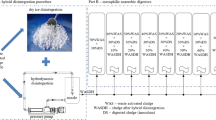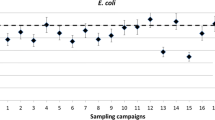Abstract
The National Environment Council (CONAMA Resolution 375/06) defined to achieve sanitation quality parameters, for the use of sewage sludge in agriculture, the adoption of additional pathogen reduction processes is necessary. Sludge that is stored for longer periods generally shows higher levels of sanitation, particularly on the helminth egg inactivations which are among the most resistant pathogens. The objective of this study was to monitor the Ascaris egg removal and inactivation efficiency of long-term storage of sludge from septic tanks and up-flow anaerobic sludge blanket (UASB) reactors, besides evaluating the influence of covering and manually revolving or stirring the sludge over a 2-year period. The study was undertaken in the cities of Fazenda Rio Grande and Apucarana, Southern Brazil. In total, 18 experimental treatments were installed and nine samples were assessed at weeks 0, 4, 9, 13, 17, 30, 47, 61, and 104. The standard defined in the CONAMA for class A sludge (one viable egg per 4 g TS) was reached for all treatments at 9 weeks of storage. Two years of storage were necessary in order for the covered, UASB-centrifuge sludge to reach CONAMA standards. Of the six treatments using septic sludge, only one achieved the established standard. This treatment was realized in Apucarana and involved a revolving/stirring process. The period of 104 weeks of storage of the septic sludge was not sufficient to completely inactivate Ascaris eggs for the other treatments. Between study locations, Apucarana performed better than Curitiba which is likely due to greater levels of insolation and temperature.







Similar content being viewed by others
References
Ahmed, A. U., & Sorensen, D. L. (1995). Kinetics of pathogen destruction during storage of dewatered biosolids. Water Environment Research, 67(2), 143–150.
Ahmed, A. U., & Sorensen, D. L. (1997). Autoheating and pathogen destruction during storage of dewatered biosolids with minimal mixing. Water Environment Research, 69(1), 81–94.
Alouini, Z., & Jemli, M. (2001). Destruction of helminth eggs by photosensitized porphyrin. Journal of Environmental Monitoring, 3(5), 548–551.
American Public Health Association (APHA). (2005). Standard methods for the examination of water and wastewater (21st ed.). Washington: American Water Works Association (AWWA) & Water Pollution Control Federation (WPCF).
Andreoli, C.V., Pegorini, E., Fernandes, F. (2001) In: ANDREOLI, C.V. (Coord). Solid waste sanitation: processing, recycling and disposal. Rio de Janeiro :RiMa/ABES (in Portuguese).
Bittencourt, S., Serrat, B. M., Andreoli, C. V., Moura, E. N., Togny, F. L., & Silva, L. A. T. P. (2013). Sewage sludge subjected to mixed: effect on total solids, pH and viable helminth eggs. Revista Acadêmica: Ciências Agrárias e Ambientais (PUCPR. Impresso), 11, S191–S200. in Portuguese.
Bittencourt, S., Serrat, B. M., Aisse, M. M., & Gomes, D. (2014). Sewage sludge usage in agriculture: a case study of its destination in the Curitiba Metropolitan Region, Paraná, Brazil. Water, Air, & Soil Pollution, 225(9), 1–8.
Bognola, I. A., Ferreira, C., Curcio, G. R., Koehler, A., & Pires, D. R. J. (2003). Semi-detailed soil survey of the Gralha Azul Farm Experimental—PR, Fazenda Rio Grande—PR. Curitiba: PUCPR (in Portuguese).
Bowman, D. D., Little, M. D., & Reimers, R. S. (2003). Precision and accuracy of an assay for detecting Ascaris eggs in various biosolid matrices. Water Research, 37(9), 2063–2072.
Brasil. (2006). Ministério do Meio Ambiente. Conselho Nacional do Meio Ambiente. Resolução CONAMA no 375, de 29 de agosto de 2006. Define critérios e procedimentos, para o uso agrícola de lodos de esgoto gerados em estações de tratamento de esgoto sanitário. www.mma.gov.br/port/conama/res/res06/res37506. pdf. Accessed 04 Ago 2016.
Bueno, R.C.R. (2001) Biossólido—Process further reduction of pathogens through the use of solar energy. In: Congresso Brasileiro de Engenharia Sanitária e Ambiental, 21, 2001, João Pessoa/PB. Anais. João Pessoa: ABES, 2001 (in Portuguese).
Carvalho, E. H. de; Andreoli, C. V.. (2015) Sludge cesspits and septic tanks in Brazil. In: Eraldo Henriques de Carvalho e Cleverson Vitório Andreoli. (Org.). Lodos de Fossa e Tanque Séptico: orientações para definição de alternativas de gestão e gerenciamento. 1ed. Curitiba/PR: ABES, 2015, v. 1, p. 35–47 (in Portuguese)
Cherubini, C., Wisnieswski, C., & Andreoli, C. V. (2002). Solorization in the southern region of Brazil, as a form of disinfection of anaerobic sewage sludge. Sanare, 18, 71–78 (in Portuguese).
Comparini, J. B. (2001)Study of pathogens decay in biosolids stored in ditches and biosolids submitted to kiln drying.278 f. Tese (Doutorado) – Escola Politécnica, Universidade de São Paulo, São Paulo (in Portuguese).
Comparini, J. B. and Além Sobrinho, P. (2003). Drying effects on agricultural greenhouse in the decay of pathogens present in biosolids. In: Saneamento Ambiental: Ética e Responsabilidade Social. ABES, 2003. p. 1–39.(in Portuguese).
Correia, J. E. (2015) Physical-chemical and microbiological characterization of sludge generated in Wastewater Treatment Plant Contorno. Feira de Santana, BA. Revista Eletrônica de Gestão e Tecnologias Ambientais, v. 2, n. 2. (in Portuguese).
Fernandes, F., Andraus, S., Andreoli, C. V., Bonnet, B. R. P., Borges, J. C., Canto, L. D. A., & Medeiros, M. L. B. D. (1996). Efficiency of sludge disinfection processes of WWTP-Belém with a view to their agricultural use. Revista Técnica da Sanepar, 5(05), 46–58 (in Portuguese).
Ferreira, A. C. (2001) Monitoring anaerobic sludge drying and disinfection in bed drying with plastic greenhouse of use and biogas. Dissertação, Mestrado, Universidade Federal do Paraná, Curitiba, 97p. (in Portuguese).
Gantzer, C., Gaspard, P., Galvez, L., Huyard, A., Dumouthier, N., & Schwartzbrod, J. (2001). Monitoring of bacterial and parasitological contamination during various treatment of sludge. Water Research, 35(16), 3763–3770.
Gonçalves, R. F., Luduvice, M., Pereira, M. R., Lima, D. L. D. C. R., Ferreira, A. C., Teles, C. R., & Andreoli, C. V. (2001). Sewage sludge dehydration. Resíduos Sólidos do Saneamento: Processamento, Reciclagem e Disposição Final, 57. (in Portuguese).
Graça, C. H. Da ; Martins, V.M.S. ; Terassi, P. M. B. ; Silveira, H. ; Stivari, S. M. S. (2011). Climate characterization as aid in the Agricultural Planning for the City of Apucarana-PR. In: XVII Congresso Brasileiro de Agrometeorologia, 2011, Guarapari, Espírito Santo. Anais. 2011. (in Portuguese).
Guzman, C., Jofre, J., Montemayor, M., & Lucena, F. (2007). Occurrence and levels of indicators and selected pathogens in different sludges and biosolids. Journal of Applied Microbiology, 103(6), 2420–2429.
IAPAR – Instituto Agronômico do Paraná. Agroclimatic Monitoring of Paraná. Historical Averages. Disponível em:http://www.iapar.org.br/ Acesso em: 09 July 2015. (in Portuguese)
IPPUC—Instituto de Pesquisa e Planejamento Urbano de Curitiba—Curitiba in data. Curitiba: IPPUC. http://ippucweb.ippuc.org.br/curitibaemdados/Curitiba_em_dados_Pesquisa.htm. mar. 2013. (in Portuguese).
Jiménez, B., Maya, C., & Galván, M. (2007). Helminth ova control in wastewater and sludge for advanced and conventional sanitation. Water Science and Technology, 56(5), 43–51.
Leles, D., Gardner, S. L., Reinhard, K., Iñiguez, A., & Araujo, A. (2012). Are Ascaris lumbricoides and Ascaris suum a single species. Parasit Vectors, 5(1), 42.
Lima, M. R. P. (2010). Use of agricultural greenhouse for drying and sanitizing sewage sludge (Doctoral dissertation, Universidade de São Paulo). (in Portuguese).
Massara, C. L., Ferreira, R. S., de Andrade, L. D., Guerra, H. L., & dos Santos Carvalho, O. (2003). Effects of detergents and disinfectants on the development of Ascaris lumbricoides eggs. Cadernos de Saúde Pública, 19(1), 335–340.
Maya, C., Ortiz, M., & Jiménez, B. (2010). Viability of Ascaris and other helminth genera non larval eggs in different conditions of temperature, lime (pH) and humidity. Water Science and Technology, 62(11), 2616–2624.
Navarro, I., Jiménez, B., Lucario, S., & Cifuentes, E. (2009). Application of helminth ova infection dose curve to estimate the risks associated with biosolid application on soil. Journal of Water and Health, 7(1), 31–44.
Paraná. Secretaria de Estado de Meio Ambiente e Recursos Hídricos. (2009). Resolução Sema 021/09. Determinations about environmental license, conditions and standards and other requirements for sanitation ventures. Diário Oficial do Estado do Paraná, Curitiba, n. 7962, pp. 13–16. (in Portuguese).
Pike, E. B. (1983). Long-term storage of sewage sludge. Processing and use of sewage sludge, Commission of the European Communities. L’Hermite (eds), D. Reidell Publishing Company.
Pompeo, R. P.; Castro, E. A.; Aisse, M. M.; Andreoli, C. V.(2014). Septic sludge sanitization subjected to 11 months of long-term storage. In: XXXIV Congreso Interamericano de Ingenieria Sanitaria y Ambiental, 2014, Monterrey. Anais. Mexico - Mexico: AIDIS, 2014. p. 1–9.
Rocha, M. C. V.da ;Barés, M.E.; Deleu, G. M.; Braga, M. C. B.(2014). Accuracy assessment of the EPA method for quantification of viable Ascaris eggs in samples from sludge drying bed. In: IWA Regional Symposium on Water, Wastewater and Environment: 2014, Patras, Grécia. Proceedings of IWA Regional Symposium on Water, Wastewater and Environment (in Portuguese).
Santos, Y. T. da C. (2010) Characterization of the contents of cesspits and septic tanks in the city of Natal. 73f. Dissertação (Mestrado em Engenharia Sanitária) - Universidade Federal do Rio Grande do Norte. 2010. (in Portuguese).
Santos, D. S. (2015) Sludge characterization obtained in blanket and bed anaerobic reactor upflow and submitted to the drying bed. Revista Eletrônica de Gestão e Tecnologias Ambientais, 2(2). (in Portuguese).
Sidhu, J. P., & Toze, S. G. (2009). Human pathogens and their indicators in biosolids: a literature review. Environment International, 35(1), 187–201.
Stefanutti, R; Andreoli, C.V.; Carneiro, P. F. N.; Santos, A. C. P. A.; Castro, E. ; Silva Junior, E. D; Siqueira, E. R.; Vasconcelos, G.V.; Nascimento, B. L. M.; Correa, J. P.; Pompeo, R. P.; Almeida, R. A.; Soccol, V. (2015) Isolated treatment of sludge cesspits and septic tanks.. In: Eraldo Henriques de Carvalho, Cleverson V. Andreoli. (Org.). Lodos de Fossa e Tanque Séptico: orientações para definição de alternativas de gestão e gerenciamento. 1ed. Curitiba/PR: ABES, 2015, v. 1, p. 161–247. (in Portuguese).
Tchobanoglous, G., & Burton, F. L. (1991). Wastewater engineering treatment, disposal and reuse (3rd ed.). New York: Metcalf and Eddy Inc.
Thomaz-Soccol, V.; Paulino, R. C.; Castro, E. A. (1999). Pathogens: helminths and protozoa. In: Andreoli C. V.; Fernandes F.; Lara I. A.(Org.). Reciclagem de Biossólidos: Transformando Problemas em Soluções. Curitiba: SANEPAR/FINEP, 1999, cap. 3, p.156-174 (in Portuguese).
Thomaz-Soccol, V.; Paulino, R.C.; Castro, E. A. (2000)Manual methods for microbiological and parasitological analysis in agricultural recycling sewage sludge. Sanepar, Curitiba, 2 ed., 2000. p. 27 – 41. (in Portuguese).
United States Environmental Protection Agency (US EPA) (1992). Environmental regulations and technology—control of pathogens and vector attraction in sewage sludge. Under 40 CFR Part 503. S.1: EPA, 1992 (EPA 625/R – 92/013).
United States Environmental Protection Agency (US EPA) (2003). Appendix I—test method for detecting, enumerating, and determining the viability of Ascarisova in sludge. In: Control ofpathogens and vector attraction in sewage sludge (including domestic septage) under 40 CFR Part 503. Cincinatti:EPA/625/R-92/013.
Veerannan, K. M. (1977). Experimental-evidence on viability of Ascaris-Lumbricoides ova. Current Science, 46(11), 386–387.
Wharton, D. A. (1979). Ascaris sp.: water loss during desiccation of embryonating eggs. Experimental Parasitology, 48(3), 398–406.
Yanko W. A., Analytical Method for Viable Helminth Ova. (1989). Laboratory section procedures for the characterization of water and wastes. 4th edition. Sanitation Districts of Los Angeles. pg 393–1 to 393–6; Los Angeles. California; 1989.
Yeager, J. G., & O’Brien, R. T. (1983). Irradiation as a means to minimize public health risks from sludge-borne pathogens. Journal Water Pollution Control Federation, 55(7), 977–983.
Acknowledgments
The authors would like to thank FINEP and CNPq for research funding through the Cross Action Environmental Sanitation and Housing program (2009), UniFAE, SANEPAR, and UFPR as co-sponsors and for technical support throughout the project. RPP acknowledges CAPES for PhD scholarship funding.
Author information
Authors and Affiliations
Corresponding author
Rights and permissions
About this article
Cite this article
Pompeo, R.P., Andreoli, C.V., de Castro, E.A. et al. Influence of Long-Term Storage Operating Conditions on the Reduction of Viable Ascaris Eggs in Sewage Sludge for Agricultural Reuse. Water Air Soil Pollut 227, 144 (2016). https://doi.org/10.1007/s11270-016-2816-0
Received:
Accepted:
Published:
DOI: https://doi.org/10.1007/s11270-016-2816-0




